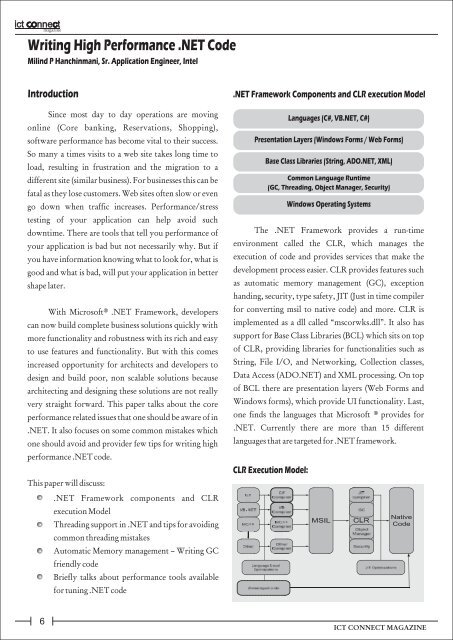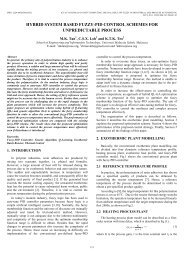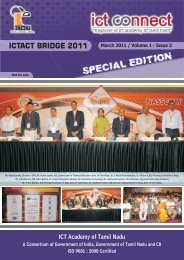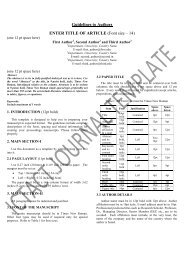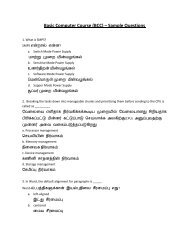Issue 1 - ICTACT.IN
Issue 1 - ICTACT.IN
Issue 1 - ICTACT.IN
Create successful ePaper yourself
Turn your PDF publications into a flip-book with our unique Google optimized e-Paper software.
magazine<br />
Writing High Performance .NET Code<br />
Milind P Hanchinmani, Sr. Application Engineer, Intel<br />
Introduction<br />
Since most day to day operations are moving<br />
online (Core banking, Reservations, Shopping),<br />
software performance has become vital to their success.<br />
So many a times visits to a web site takes long time to<br />
load, resulting in frustration and the migration to a<br />
different site (similar business). For businesses this can be<br />
fatal as they lose customers. Web sites often slow or even<br />
go down when traffic increases. Performance/stress<br />
testing of your application can help avoid such<br />
downtime. There are tools that tell you performance of<br />
your application is bad but not necessarily why. But if<br />
you have information knowing what to look for, what is<br />
good and what is bad, will put your application in better<br />
shape later.<br />
With Microsoft® .NET Framework, developers<br />
can now build complete business solutions quickly with<br />
more functionality and robustness with its rich and easy<br />
to use features and functionality. But with this comes<br />
increased opportunity for architects and developers to<br />
design and build poor, non scalable solutions because<br />
architecting and designing these solutions are not really<br />
very straight forward. This paper talks about the core<br />
performance related issues that one should be aware of in<br />
.NET. It also focuses on some common mistakes which<br />
one should avoid and provider few tips for writing high<br />
performance .NET code.<br />
This paper will discuss:<br />
.NET Framework components and CLR<br />
execution Model<br />
Threading support in .NET and tips for avoiding<br />
common threading mistakes<br />
Automatic Memory management – Writing GC<br />
friendly code<br />
Briefly talks about performance tools available<br />
for tuning .NET code<br />
.NET Framework Components and CLR execution Model<br />
Languages (C#, VB.NET, C#)<br />
Presentation Layers (Windows Forms / Web Forms)<br />
Base Class Libraries (String, ADO.NET, XML)<br />
Common Language Runtime<br />
(GC, Threading, Object Manager, Security)<br />
Windows Operating Systems<br />
The .NET Framework provides a run-time<br />
environment called the CLR, which manages the<br />
execution of code and provides services that make the<br />
development process easier. CLR provides features such<br />
as automatic memory management (GC), exception<br />
handing, security, type safety, JIT (Just in time compiler<br />
for converting msil to native code) and more. CLR is<br />
implemented as a dll called “mscorwks.dll”. It also has<br />
support for Base Class Libraries (BCL) which sits on top<br />
of CLR, providing libraries for functionalities such as<br />
String, File I/O, and Networking, Collection classes,<br />
Data Access (ADO.NET) and XML processing. On top<br />
of BCL there are presentation layers (Web Forms and<br />
Windows forms), which provide UI functionality. Last,<br />
one finds the languages that Microsoft ® provides for<br />
.NET. Currently there are more than 15 different<br />
languages that are targeted for .NET framework.<br />
CLR Execution Model:<br />
6<br />
ICT CONNECT MAGAZ<strong>IN</strong>E


